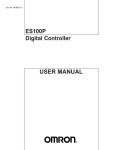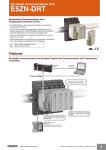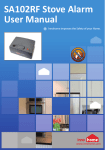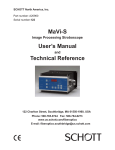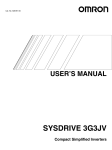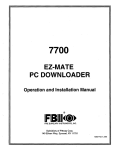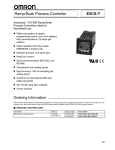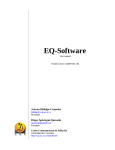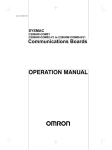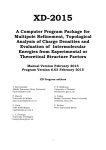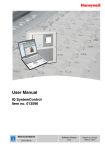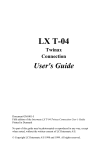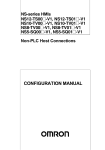Download Temperature Controllers Selection Guide
Transcript
Cat.No.Y101-E1-03 CONTENTS Product Lineup . . . . . . . . . . . . . . . . . . . . . . . . . . . . . . . . . . Temperature Controller Selection 1 . . . . . . . . . . . . . . . . . Temperature Controller Selection 2 . . . . . . . . . . . . . . . . . Output Device Selection . . . . . . . . . . . . . . . . . . . . . . . . . . . Input Device Selection . . . . . . . . . . . . . . . . . . . . . . . . . . . . . Applications . . . . . . . . . . . . . . . . . . . . . . . . . . . . . . . . . . . . . Selection Guide . . . . . . . . . . . . . . . . . . . . . . . . . . . . . . . . . . Technical Information . . . . . . . . . . . . . . . . . . . . . . . . . . . . . Glossary . . . . . . . . . . . . . . . . . . . . . . . . . . . . . . . . . . . . . . . . Standards . . . . . . . . . . . . . . . . . . . . . . . . . . . . . . . . . . . . . . . 4 6 8 10 11 12 16 25 29 38 3 Cycle Control Cycle Control Units G32A-EA G3PA G3PC ON/OFF Control SSRs Digital Temperature Controllers G3PB (Single-phase) G3PB (Three-phase) G3NA Phase Control Power Controllers ES100P ES100X G3PX (Single-phase) G3PX (Three-phase) Modular Temperature Controllers E5ZN Multi-point Temperature Controllers Block-type Switching Power Supplies S8TS Data Recorder E55A-E/-F Interface Converters K3SC (DeviceNet) Switching Power Supplies S8VS PLC Units Heater Burnout Alarms K2CU Intelligent Signal Processors K3NH/K3MA-L CJ1W-TC C200H-TC/-TV/-PID CQM1-TC 5 Temperature Temperature Controller Controller Selection Selection 11 Equipped with nearly all the standard functions required in Temperature Controllers to allow use in a wide variety of machines and control panels. A Variety of Different Sizes Compact The lineup includes the compact E5GN (48 24 mm) and the E5AN (96 96 mm), which has a large display and keys. A depth of 78 mm allows these Temperature Controllers to fit into thinner control panels E5CJ (except for the E5GN). The front panel (48 48 mm) of the E5GN has dimensions of 48 24 mm for double-size display of PVs and SPs. 40 mm E5GN (48 24 mm) Improvements in Basic Functions and Performance Equipped with the performance and functionality, including auto-tuning and self-tuning, to fulfill almost any kind of temperature control application. Energy Savings and High Reliability Unique power supply technology enables an energy saving of 40% compared to existing models (power consumption: approx. 7 VA). The suppression of heat generation and improved reliability ensure at least 3 years of use. E5CN (Approx. 7 VA) 40% energy saving Existing models (Approx. 12 VA) (E5CJ) (Power consumption) For smaller installations... Downsize the installation by using a Programmable Terminal for both operation and display. These Temperature Controllers are recommended for applications not requiring setting and display at the front of the panel. 22.5 mm Expansion According to Necessity The Temperature Controller can be replaced without changing the wiring, meaning less work and fewer wiring errors. 6 Modular Temperature Controllers Less Maintenance Required Simpler Setup Ultra-slim model of width 22.5 mm. Side connectors are used for power supply and RS-485 connections between Units and so wiring between the panel surface and the panel interior is only required for the display device. E5ZN The number of temperature input points can be increased without adding operating panels or restructuring the control panel. Temperature control can be performed for 2 channels per Unit up to a maximum of 32 channels. Easier Software Development Using the E5ZN-SDL to set items that do not require setting with an operating panel eliminates the need for software to make and display multiple settings. Setting Display Unit E5ZN-SDL PV SV OUT1 OUT2 MANU STOP RMT AT SUB1 A M E5CK PV SV OUT1 OUT2 MANU STOP RMT AT SUB1 A M E5CK 8 E5CS E5C2 E5L 9 G32A Applications Fryer A low-cost Temperature Controller that has a process value display is required for the temperature control of a fryer. E5CN Oil Oil Temperature sensor Alarm output Oil-flow sensor Gas burner E5CN Shut-off valve Buzzer Gas Oil-flow sensor: The oil-flow sensor detects the flow of oil and shuts off the burner if there is a decrease in the quantity of oil flow. Temperature Controller: The Temperature Controller is in ON/OFF control of the oil temperature at 160°C. If the oil temperature exceeds 180°C, the alarm output turns ON, the buzzer goes off, and the valve is shut-off. Rack-type Oven at a Bakery Changes in temperature setting are required for various types of bread. E5EN Heater Temperature sensor Bread A E5EN Temperature Controller Example: Set point 0 for bread A: 170°C Set point 1 for bread B: 180°C Set point 2 for bread C: 190°C Set point 3 for bread D: 200°C Max. 4 set points Set value selector Four set points can be stored in the memory of the E5EN, any of which can be selected with ease. Injection Molding Machine E5ZE Changes in control temperature and PID constants are required for various types of products. The control temperature and PID constants are selected according to the product type. Mold E5ZD 7 sensors E5ZE E5ZE E5ZE Banks available E5ZE E5ZE The bank is selected with the Programmable Controller. The E5ZE is a multipoint, single-board Temperature Controller with 8 banks. Use the C200HX, C200HG, or C200HE Programmable Controller to select the data in each bank, such as control temperature and PID constant data for product control. The SYSMAC C200HX, C200HG, and C200HE Programmable Controllers have a built-in protocol macro function. 12 Applications Constant Temperature Oven Simple but precise temperature control is required for a constant temperature oven. ES100P ES100P Heater Temperature Constant temperature oven minutes The temperature pattern is set in the ES100P Digital Controller operating with a start signal. Furnace E5jK High-precision temperature control is required for a furnace. ESI BaF2 window ESI E5jK Products Furnace Packing Machine The E5jK Digital Controller and the ES1 Non-contact Sensor are used in combination to check the temperature of the product for precise quality control. The temperature of the processed products can be checked for precise quality control. Apply BaF2 infrared-transparent material to the windows. Less space and wiring work are required for packing machines. CPM2C E5ZN-2j E5ZN E5ZN-SCTjS E5ZN-SDL With the E5ZN Modular Temperature Controller, the control panel can be downsized and wiring between the panel surface and the panel interior is only required for the display device. In addition, connecting a CPM2C–CIF21 Simple Communications Unit eliminates the need for communications programming. 13 Applications Serial Communications Tunnel Furnace • Flexible expansion is possible in Unit–configured installations. • Programming requirements can be reduced using the CPM2C–CIF21. • Combining with a computer enables use of data logging and recipe functions. CPM2CCIF21 E5ZN Advantage CPM2C Computer for data maintenance E5ZN-SDL Applications • Baking furnace (tunnel furnace) Conveyor control Explanation • The temperature and conveyor control systems are separate. • User maintenance is easy. SSR SSR Tunnel furnace SP Ramp Ceramic Baking Furnace Advantage • SP ramp Prevents workpieces from radical heating. Target value Applications • Applications where the thermal shock is unfavorable. • Simple program control SP ramp set value SP ramp time Time Explanation • The ceramic baking furnace is in temperature control with a gas burner. • A smooth temperature rise is required because the ceramic material may crack if there is a sudden temperature rise. E5CK 4 to 20 mA (transmission output) Temperature sensor 4 to 20 mA (current output) Recorder Burner 14 Applications Tunnel Furnace (Electric Furnace) Remote SP Start Advantage • Reset Uses external 4- to 20-mA analog signals as SP values. Pattern selection Applications • E5AK E5AK Zone control of tunnel furnace Explanation • The electric furnace is in zone control using the remote SP function of the Digital Controllers. • Three Digital Controllers are used to make the furnace temperature even. • Selectable patterns are stored in the ES100P. The system is in operation with the start signal and according to the selected pattern. • The remote SP function is in control of the three zones with the same pattern. Remote signal Remote signal ES100P G3PX Temperature sensor G3PX Temperature sensor G3PX Temperature sensor Electric furnace Heater Heater Heater Water Tank Level Control (3-position Control) Input Digital Filter PV before filtered Advantage • Smooths radical input changes. Filtered PV Applications • Applications with quick thermal response, if the unstable process value unfavorably affects the control of the systems. • A reduction in noise, if the noise unfavorably affects the process value. Input digital filter E5AK Dead band Explanation • The water level of the tank is checked with a supersonic level meter while the water supply and drain pumps are in ON/OFF control. • The water surface undulates, thus making the process value (PV) unstable. Therefore, an input digital filter is applied to alleviate the fluttering of the process value. Time Time constant Hysteresis Hysteresis Water supply Drainage Target value Level meter Water supply Drainage 15 Selection Guide E5jN Use General-purpose models Model type Digital Temperature Controller Model E5jN E5CN-U Item Standard/Communications type Plug-in Size 96 x 96 E5AN Control d mode ON/OFF Yes PID --- 2-PID Yes 48 x 96 48 x 48 48 x 24 E5EN E5CN E5GN 48 x 48 E5CN-U Auto-tuning function Yes Self-tuning function Yes Hysteresis in ON/OFF control action 0.1 to 999.9 EU (in units of 0.1 EU) Indication accuracy Thermocouple: (±0.5% of indicated value or ±1°C, whichever greater) ±1 digit max. (see note) Platinum resistance thermometer: (±0.5% of indicated value or ±1°C, whichever greater) ±1 digit max. Analog input: ±0.5% FS±1 digit max. CT input: ±5% FS±1 digit max. Input Thermocouple: K, J, T, E, L, U, N, R, S, B Platinum resistance thermometer: Pt100, JPt100 Infrared temperature sensor: 10 to 70°C, 60 to 120°C, 115 to 165°C, 160 to 260°C Voltage input: 0 to 50 mV Output Relay, voltage, and current output (E5GN: Relay, voltage) Relay, voltage Heater burnout (not used with current output) Yes (E5AN, E5EN, E5CN) --- Communication RS-232C (E5AN/E5EN), RS-485 (E5AN/E5EN/E5CN/E5GN) --- Supply voltage 100 to 240 VAC or 24 VAC/DC Terminal configuration Screw terminals EMC Conforms to EN55011 Group 1 class A, EN55011 Group 1 class A, EN61000-4-2, ENV50140, ENV50141, EN61000-4-4 Approved standards UL, CSA Datasheet Cat. No. H107: E5AN/EN/CN/GN Datasheet Manual Cat. No. H100: H101: H111: H112: H102: Note: 16 Thermocouple: (±1% of indicated value or ±2°C, whichever greater) Platinum resistance thermocouple: (±0.5% of indicated value or ±1°C, whichever greater) Plug-in H109: E5CN-U Datasheet E5CN User’s Manual E5GN User’s Manual E5EN User’s Manual E5AN User’s Manual E5AN/EN/CN/GN Communication Manual This page provides information on main specifications only. Be sure to read the information on detailed specifications and precautions before using the models listed here. Selection Guide E5jK Use General-purpose models Model type Digital Process Controller Model E5jK Function Standard Item Standard type Size 96 x 96 E5AK Control mode d ON/OFF Yes PID --- 2-PID Yes PID with fuzzy control --- E5AK/E5EK Position proportional Communications type 48 x 96 53 x 53 E5EK E5CK 96 x 96 E5AK Standard type Communications type 48 x 96 53 x 53 96 x 96 48 x 96 96 x 96 48 x 96 E5EK E5CK E5AK E5EK E5AK E5EK Auto-tuning function Yes Self-tuning function Yes Hysteresis in ON/OFF control action 0.01% to 99.99% FS (in units of 0.01%) Indication accuracy Thermocouple: (±0.3% of indicated value or ±1°C, whichever greater) ±1 digit max. Platinum resistance thermometer: (±0.2% of indicated value or ±0.8°C, whichever greater) ±1 digit max. Analog input: ±0.2% FS ±1 digit max. Input K, J, T, L, U, N, R, S, B, W, PLII, JPt100, or PT100 Current or voltage input Output (Optional) Relay, SSR, voltage, linear voltage, and linear current output Relay output Heater burnout (not used with current output) Yes (E5AK/E5EK) Loop burnout alarm is available (E5AN/E5EK/E5CK) --- Communication RS-232C, RS-422, RS-485 Supply voltage 100 to 240 VAC or 24 VAC/DC at 50/60 Hz Terminal configuration Screw terminals EMC Conforms to EN50081-2, EN50082-2 Approved standards UL, CSA Datasheet Cat. No. H084: E5AK/EK Digital Controller DS H079: E5CK Digital Controller Cat. Manual Cat. No. H083: E5AK User’s Manual H085: E5EK User’s Manual H078: E5CK User’s Manual Note: This page provides information on main specifications only. Be sure to read the information on detailed specifications and precautions before using the models listed here. 17 Selection Guide E5jK-T Programmable Type Use General-purpose models Model type Digital Process Controller Model E5jK-T programmable type Function Standard Item Standard type Size 96 x 96 Position proportional Communications type 48 x 96 96 x 96 48 x 96 53 x 53 E5AK-TA Control mode d ON/OFF Yes PID --- 2-PID Yes PID with fuzzy control --- E5CKE5EK-TA TA Standard type 96 x 96 48 x 96 E5AK-TA E5EK-TA 53 x 53 E5AK-TA E5CKE5EK-TA TA Communications type 96 x 96 E5AK-TA 48 x 96 E5EK-TA Auto-tuning function Yes Self-tuning function Yes Hysteresis in ON/OFF control action 0.01% to 99.99% FS (in units of 0.01%) Indication accuracy Thermocouple: (±0.3% of indicated value or ±1°C, whichever greater) ±1 digit max. Platinum resistance thermometer: (±0.2% of indicated value or ±0.8°C, whichever greater) ±1 digit max. Analog input: ±0.2% FS ±1 digit max. Input K, J, T, L, U, N, R, S, B, W, PLII, JPt100, or PT100 Current or voltage input Output (Optional) Relay, SSR, voltage, linear voltage, and linear current output Relay output Heater burnout (not used with current output) Yes (E5AK/E5EK) Loop burnout alarm is available (E5AN/E5EK/E5CK) --- Communication RS-232C, RS-422, RS-485 Supply voltage 100 to 240 VAC or 24 VAC/DC at 50/60 Hz Terminal configuration Screw terminals EMC Conforms to EN50081-2, EN50082-2 Approved standards UL, CSA Datasheet Cat. No. H087: E5jK-T Digital Controller DS Manual Cat. No. H088: E5AK User’s Manual (Programmable Type) H089: E5EK User’s Manual (Programmable Type) H090: E5CK User’s Manual (Programmable Type) Note: 18 This page provides information on main specifications only. Be sure to read the information on detailed specifications and precautions before using the models listed here. Selection Guide E5CS Use General-purpose models Model type Digital Temperature Controller Model E5CS E5CS-X Item Plug-in Basic Size 48 x 48 Control d mode ON/OFF Yes PID Yes 2-PID --- PID with fuzzy control --- Auto-tuning function --- Self-tuning function Yes Hysteresis in ON/OFF control action 0.2% FS fixed Indication accuracy ±1% FS ± 1 digit max. Input K, J, L, JPt100, Pt100 or thermistor Output Relay or voltage output Supply voltage 100 to 240 VAC or 24 VAC/VDC at 50/60 Hz Terminal configuration Plug-in model EMC Conforms to EN50081-2, EN50082-2 Approved standards UL, CSA Datasheet Cat. No. H042 Note: 48 x 48 ±0.5% FS ± 1 digit max. Screw terminals H032 This page provides information on main specifications only. Be sure to read the information on detailed specifications and precautions before using the models listed here. 19 Selection Guide E5C2, E5L Use General-purpose models Model type Analog Temperature Controller Digital Thermometer Model E5C2 E5L Item Basic Basic Size 48 x 48 Digital Thermometer (with external setting device) Control mode d ON/OFF Yes PID P action 2-PID --- PID with fuzzy control --- External setting device Panel meter --- Auto-tuning function --- Self-tuning function --- Hysteresis in ON/OFF control action 0.5% FS fixed Variable Indication accuracy ±2% FS max. ±2% FS max. Input K, J, JPt100, and THE THE (element-compatible thermistor) Output Relay output Supply voltage 100/110, 200/220 VAC at 50/60 Hz Terminal configuration Plug-in model EMC Conforms to EN50081-2, EN50082-2 --- Approved standards UL, CSA --- Datasheet Cat. No. H081 H020 Note: 20 100, 110, 200, 220 (individual) VAC at 50/60 Hz (common) This page provides information on main specifications only. Be sure to read the information on detailed specifications and precautions before using the models listed here. Selection Guide E5LC, E5LD Use Economy models Model type Temperature Display Digital Thermometer Model E5LC E5LD Item Temperature display only ON/OFF control type ON/OFF --- Yes PID --- 2-PID --- PID with fuzzy control --- Size Control d mode Auto-tuning function --- Self-tuning function --- Hysteresis in ON/OFF control action --- 0.5 to 9.0°C (in units of 0.5°C) Setting accuracy --- ±1°C + 1 digit max. Indication accuracy ±1°C ± 1 digit max. Input Mono-block thermistor Output --- Heater burnout (not used with current output) --- Supply voltage --- 100, 200 VAC (depends on model) at 50/60 Hz (common) Terminal configuration --- Screw terminals EMC Conforms to EN50081-2, EN50082-2 --- Approved standards --- Datasheet Cat. No. H035 Note: Relay This page provides information on main specifications only. Be sure to read the information on detailed specifications and precautions before using the models listed here. 21 Selection Guide E5ZE, E5ZD Use Multipoint control models Model type Multipoint Temperature Controller Model E5ZE Item --- E5ZD E5ZD-8F Size Control d mode ON/OFF Yes PID --- 2-PID --- Yes --- PID with fuzzy control Yes --- Yes Auto-tuning function Yes Self-tuning function --- Hysteresis in ON/OFF control action 0.0 to 99.9°C/°F for ON/OFF control only (in units of 0.1°C/°F) Indication accuracy Thermocouple: ±0.3% or ±2°C of indicated value (whichever is larger) ± 1 digit max. Platinum resistance thermometer: ±0.3% or ±0.8°C (whichever is larger) ± 1 digit max. ±0.5% FS ± 1 digit max. Input K, J, R, S, T, E, B, N, L, U, W/Re5-26, PT II, Pt100, or JPt100 K, J, JPt100, or Pt100 Output Voltage or current output Voltage or open collector output Heater burnout (not used with current output) Yes Supply voltage 24 VDC Terminal configuration Screw terminals Dedicated terminal EMC Conforms to EN50081-2, EN50082-2 --- Approved standards --- Datasheet Cat. No. H075 H060 Manual Cat. No. H077: E5ZE Communications Manual H076: E5ZE Operation Manual Z042: Z084: Note: 22 E5ZD Operation Manual (European Version) E5ZD-jV Operation Manual (European Version) This page provides information on main specifications only. Be sure to read the information on detailed specifications and precautions before using the models listed here. Selection Guide E5ZN Use Din track mounting models Model type Module Temperature Controller Model E5ZN Item Communications type Size (Terminal Unit sold separately) Control d mode ON/OFF Yes PID --- 2-PID Yes Setting display Auto-tuning function Self-tuning function --- Hysteresis in ON/OFF control action 0.1 to 999 EU (in units of 0.1 EU) Indication accuracy Thermocouple: (±0.5% of indicated value or ±1°C, whichever greater) ±1 digit max. Platinum resistance thermometer: (±0.5% of indicated value or ±1°C, whichever greater) ±1 digit max. Analog input: ±0.5% FS ±1 digit max. Input Thermocouple: K, J, T, E, L, U, N, R, S, B Infrared temperature sensor: ES1A series Voltage input: 0 to 50 mV Platinum resistance thermometer: Pt100, JPt100 Output Voltage, transistor, or current output Heater burnout (not used with current output) Yes Supply voltage 24 VAC/DC Terminal configuration Screw terminal (Terminal Unit sold separately) EMC EN61326 Approved standards UL, CSA Datasheet Cat. No. H116 Manual Cat. No. H113 Note: This page provides information on main specifications only. Be sure to read the information on detailed specifications and precautions before using the models listed here. 23 Selection Guide ES100 Use Current and voltage input models Model type Process Controller Model ES100X, ES100P Item Digital Controller Size Control d mode ON/OFF Yes PID --- 2-PID Yes PID with fuzzy control Yes 96 x 96 96 x 96 ES100X (fixed value type) ES100P (programmable type) Auto-tuning function Yes Self-tuning function --- Hysteresis in ON/OFF control action 0.01% to 99.99% FS in 0.01% FS increments Indication accuracy ±0.1% FS ± 1 digit max. Input K, J, T, E, R, S, B, N, L, U, PL II, W, Pt100, or JPt100 voltage or current input Output Output Unit available to relay, SSR, voltage, and current output. Heater burnout (not used with current output) Yes Supply voltage 100 to 240 VAC 50/50 Hz Terminal configuration Screw terminals EMC --- Approved standards UL, CSA Datasheet Cat. No. H058 Manual Cat. No. H072: ES100 Communications Guide H069: ES100P Digital Controller Programmer User’s Guide H115: ES100 Support Software ES/TOOLS for Windows Operation Manual H070: ES100X Digital Controller User’s Manual Note: This page provides information on main specifications only. Be sure to read the information on detailed specifications and precautions before using the models listed here. Watertight Covers Model Y92A-jj Size 96 x 96 72 x 72 21.9 48 x 96 21.9 (2) 21.9 14 (2) (2) 69 87.7 79.2 107.7 131.7 48 x 48 21.9 (2) 131.7 12 67.6 91.6 115.6 Y92A-96N Degree of protection IP66 or NEMA4 (indoors) Datasheet Cat. No. Q088 24 29.4 67.6 29.4 Y92A-72N 29.4 Y92A-49N Y92A-48N Technical Information Configuration Example of Temperature Control The following is an example of the configuration of temperature control. • • • Relay output Voltage output Current output • • • • • • SSR Cycle controller Power controller Thermocouple Platinum resistance thermometer Thermistor Controlled object Temperature Controller Control signal Controller Temperature Sensor The Temperature Sensor consists of an element protected with a pipe. Locate the element, which converts temperatures into electric signals, in places where temperature control is required. Electronic Temperature Controller The Electronic Temperature Controller is a product that receives electric signal input from the temperature sensor, compares the electric signal input with the set point, and outputs adjustment signals to the Controller. Controller The Controller is used to heat up or cool down furnaces and tubs using a device, such as a solenoid or fuel valve, to switch electric currents supplied to heaters or coolers. Temperature Control 3. The response is slow in reaching the set point. Temperature Temperature 1. The temperature stabilizes after overshooting several times. Time Time 2. Proper response Temperature The set point is input into the Temperature Controller in order to operate the Temperature Controller. The time required for stable temperature control varies with the controlled object. Attempting to shorten the response time will usually result in the overshooting or hunting of temperature. When reduce the overshooting or hunting of temperature, the response time must not be shortened. There are applications that require prompt, stable control in the waveform shown in (1) despite overshooting. There are other applications that require the suppression of overshooting in the waveform shown in (3) despite the long time required to stabilize temperature. In other words, the type of temperature control varies with the application and purpose. The waveform shown in (2) is considered to be a proper one for standard applications. Time 25 Technical Information Characteristics of the Controlled Object Before selecting the Temperature Controller and Temperature Sensor models, it is necessary to understand the thermal characteristics of the controlled object for proper temperature control. Heat capacity, which indicates the degree of ease of heating, varies with the capacity of the furnace. Static characteristics Static characteristics, which indicate the capability of heating, vary with the capacity of the heater. Dynamic characteristics Dynamic characteristics, which indicate the startup characteristics (i.e., excessive response) of heating, vary with the capacities of the heater and furnace that affect each other in a complex way. External disturbances are causes of temperature change. For example, the opening or closing of the door of a constant temperature oven will be a cause of external disturbance thus creating a temperature change. External disturbances ON/OFF Control Action As shown in the graph below, if the process value is lower than the set point, the output will be turned ON and power will be supplied to the heater. If the process value is higher than the set point, the output will be turned OFF with power to the heater shut off. This control method is called ON/OFF control action, in which the output is turned ON and OFF on the basis of the set point to keep the temperature constant. In this operation, the temperature is controlled with two values (i.e., 0% and 100% of the set point). Therefore, the operation is also called two-position control action. Characteristics of ON/OFF control action Hysteresis P Action P action (or proportional control action) is used for obtaining the output in proportion to the input. The Temperature Controller in P action has a proportional band with the set point in the proportional band. The control output varies in proportion to the deviation in the proportional band. In normal operation, a 100% control output will be ON if the process value is lower than the proportional band. The control output will be decreased gradually in proportion to the deviation if the process value is within the proportional band, and a 50% control output will be ON if the set point coincides with the process value (i.e., there is no deviation). This means P action ensures smooth control with minimal hunting compared with the ON/OFF control action. Set point Time Control output Proportional control action Example: If a Temperature Controller with a temperature range of 0° to 400°C has a 5% proportional band, the width of the proportional band will be converted into a temperature range of 20°C. In this case, provided that the set point is 100°C, a full output is kept turned ON until the process value reaches 90°C, and the output is OFF periodically when the process value exceeds 90°C. When the process value is 100°C, there will be no difference in time between the ON period and the OFF period (i.e., the output is turned ON and OFF with the same interval). Control output Characteristics of controlled object Heat capacity A narrow proportional band is set. A wide proportional band is set. Set point A narrow proportional band is set. Heater Temperature Set point Set point Offset Proportional band A wide proportional band is set. Time 26 Technical Information I Action D Action I action (or integral control action) is used for obtaining the output in proportion to the time integral value of the input. P action causes an offset. Therefore, if proportional control action and integral control action are used in combination, the offset will be reduced as the time goes by until finally the control temperature will coincide with the set point and the offset will cease to exist. Offset PI (proportional and integral control) action Time PID control External disturbance P (proportional control) action only Time A short integral time is set. A long integral time is set. Control output Control output PID control is a combination of proportional, integral, and derivative control actions, in which the temperature is controlled smoothly by proportional control action without hunting, automatic offset adjustment is made by integral control action, and quick response to an external disturbance is made possible by derivative control action. PD (proportional and derivative control) action P (proportional control) action only Set point Set point Offset ceases to exist. PID Control D action (or derivative control action) is used for obtaining the output in proportion to the time derivative value of the input. Proportional control action corrects the result of control and so does integral control action. Therefore, proportional control action and integral control action respond slowly to temperature change, which is why derivative control action is required. Derivative control action corrects the result of control by adding the control output in proportion to the slope of temperature change. A large quantity of control output is added for a radical external disturbance so that the temperature can be quickly in control. A long derivative time is set. A short derivative time is set. Time A short integral time is set. Time Set point A long derivative time is set. Set point A long integral time is set. A short derivative time is set. Time Time 27 Technical Information 2-PID Control Conventional PID control uses a single control block to control the responses of the Temperature Controller to a target value and external disturbances. Therefore, the response to the target value will oscillate due to overshooting if importance is attached to the response to external disturbances with the P and I parameters set to small values and the D parameter set to a large value in the control block. On the other hand, if importance is attached to the response to the target value (i.e., the P and I parameters are set to large values), the Temperature Controller will not be able to respond to external disturbances quickly. It will be impossible to satisfy both the types of responses in this case. 2-PID control eliminates this weakness while retaining the strengths of PID control, thus making it possible to improve both types of responses. PID Control 2-PID Control Response to the target value will become slow if response to the external disturbance is improved. Response to target value Response to external disturbance Controls both the target value response and external disturbance response. Response to the external disturbance will become slow if response to the target value is improved. PID with Fuzzy Control By adding fuzzy control to PID control, further improvement in response to external disturbances is possible. PID and fuzzy control usually operate as PID control. If there is external disturbance, fuzzy control will operate in combination with PID control. OMRON’s fuzzy control estimates temperature change from the difference between the deviation (i.e., the difference between the set point and process value) and deviation change rate, and then makes the delicate adjustment of the control output. PID control Set point External disturbance An increase in output. PID and fuzzy control Suppresses the output to eliminate overshooting. Control on the basis of the deviation and deviation change rate. 28 Response to the target value. Response to external disturbance PID control PID and fuzzy control Glossary Control Hysteresis Hunting and Overshooting Derivative Time ON/OFF control action turns the output ON or OFF on the basis of the set point. This means the output frequently changes according to minute temperature changes, which shortens the life of the output relay or unfavorably affects some devices connected to the Temperature Controller. Therefore, a margin is prepared between the ON and OFF operations. This margin is called hysteresis. ON/OFF control action often involves the waveform shown in the following graph. A temperature rise in excess of the set point after temperature control starts is called overshooting. Temperature oscillation near the set point is called hunting. Improved temperature control is to be expected if the degrees of overshooting and hunting are low. Derivative time is the period required for a ramp-type deviation in derivative control (e.g., the deviation shown in the following graph) to coincide with the control output in proportional control action. The longer the derivative time is, the stronger the derivative control action is. Overshooting PD action (with a short derivative time) PD action (with a long derivative time) Example: If the Temperature Controller with a temperature range of 0°C to 400°C has a 0.2% hysteresis, D will be 0.8°C. Therefore if the set point is 100°C, the output will turn OFF at a process value of 100°C and will turn ON at a process value of 99.2°C. Control Cycle and Time-proportioning Control Action The control output will be turned ON intermittently according to a preset cycle if P action is used with a relay or SSR. This preset cycle is called control cycle and this control method is called time-proportioning control action. Offset Set point Temperature Set point Proportional control action causes an error in the process value due to the heat capacity of the controlled object and the capacity of the heater, which results in a small discrepancy between the process value and set point in stable operation. This error is called offset. Offset may exist above or below the set point. Proportional band Control output Hunting Temperature Offset PD Action and Derivative Time Deviation D: Hysteresis Set point Control output Hysteresis Hunting and Overshooting in ON/OFF Control Action P action D2 action (with a short derivative time) D1 action TD: Derivative time (with a long derivative time) Actual temperature The higher the temperature is, the shorter the ON period is. Proportional band T: Control cycle Offset Control output = TON TON + TOFF x 100 (%) TON: ON period TOFF: OFF period Example; If the control cycle is 10 s with an 80% control output, the ON and OFF periods will be the following values. TON: 8 s TOFF: 2 s 29 Glossary ARW Function Integral Time ARW stands for anti-reset windup. There is usually a large deviation (i.e., a large difference between the process value and set point) when the Temperature Controller starts operating. Integral control action in PID control is repeated until the temperature reaches the set point. As a result, an excessive integral output causing overshooting is output. To prevent this, the ARW function sets a limit to restrict the output rise in integral control action. In normal control operation, the integral output is eliminated until the process value reaches the proportional band. Integral time is the period required for a steptype deviation in integral control (e.g., the deviation shown in the following graph) to coincide with the control output in proportional control action. The shorter the integral time is, the stronger the integral control action is. If the integral time is too short, however, hunting may result. Overshooting due to excessive integral output. Deviation Temperature or deviation PI Action and Integral Time PI action (with a short integral time) PI action (with a long integral time) Control output Set point Proportional band Deviation Integral output Time P action T1: Integral time (with a short integral time) (with a long integral time) Initial integral output with ARW function disabled. Initial integral output with ARW function enabled. Time Auto-tuning Marginal Sensitivity Method Limit Cycle Method Proportional control action starts from the start point A in this method. Narrow the width of the proportional band until the temperature starts to oscillate. Then obtain the PID constants from the value of the proportional band and the oscillation cycle T at that time. ON/OFF control action starts from the start point A in this method. Then obtain the PID constants from the hunting cycle T and oscillation D. Hunting cycle Time Step Response Method Set point The value most frequently used must be the set point in this method. Calculate the maximum temperature ramp R and the dead time L from a 100% step-type control output. Then obtain the PID constants from R and L. Time 30 Oscillation Set point Set point PID constants for temperature control vary in value and combination according to the characteristics of the controlled object. There has been a variety of conventional methods suggested and implemented to obtain PID constants from the waveforms of temperatures to be controlled by the Temperature Controller in actual operation. Among them, auto-tuning methods make it possible to obtain PID constants suitable to a variety of objects. Auto-tuning methods include the step response, marginal sensitivity, and limit cycle methods. Marginal sensitivity method Time Glossary Readjustment of PID Constants PID constants calculated in auto-tuning operation normally do not cause problems except for some particular applications, in which case, refer to the following to readjust the PID constants. Response to Change in Integral Time Response to Change in Derivative Time Wider Wider Set point Set point Response to Change in Proportional Band Wider Set point It is possible to reduce hunting, overshooting, and undershooting although a comparatively long startup time and set time will be required. The process value reaches the set point within a comparatively short time with comparatively small amounts of overshooting and undershooting although fine-cycle hunting will result due to the change in process value. Narrower It is possible to suppress overshooting although a comparatively long startup time and set time will be required. Narrower Set point Set point Narrower Set point The process temperature reaches the set point within a comparatively short time although overshooting, undershooting, and hunting will result. It will take a comparatively long time for the process value to reach the set point with heavy overshooting and undershooting. The process value reaches the set point within a comparatively short time and keeps the temperature stable although overshooting and hunting will result until the temperature becomes stable. Fuzzy Self-tuning PID constants must be determined according to the controlled object for proper temperature control. The conventional Temperature Controller incorporates an auto-tuning function to calculate PID constants, in which case, it will be necessary to give instructions to the Temperature Controller to trigger the auto-tuning function. Furthermore, if the limit cycle method is adopted, temperature disturbance may result. The Temperature Controller in fuzzy self-tuning operation determines the start of tuning and ensures smooth tuning without disturbing temperature control. In other words, the fuzzy self-tuning function makes it possible to adjust PID constants according to the characteristics of the controlled object. Fuzzy Self-tuning in 3 Modes • PID constants are calculated by tuning at the time of change in the set point. • When an external disturbance affects the process value, the PID constants will be adjusted and kept in a specified range. • If hunting results, the PID constants will be adjusted to suppress the hunting. Auto-tuning Method of a Conventional Temperature Controller Auto-tuning Function: Automatically calculates the appropriate PID constant for controlling objects. Features: 1. Tuning will be performed when the AT instruction is given. 2. The limit cycle signal is generated to oscillate the temperature before tuning. Self-tuning Function Self-tuning (ST) Function: A function to automatically calculate optimum PID constants for controlled objects. Features: 1. Whether to perform tuning or not is determined by the Temperature Controller. 2. No signal disturbing the process value is generated. External disturbance 1 Target value PID gain calculated. External disturbance 2 Temperature in control Temperature in control ST starts. Target value AT starts. Temperature oscillated. PID gain calculated. AT instruction 31 Glossary Self-tuning Function Fine-tuning Function Set point (Applicable Model: E5CS) The self-tuning function is incorporated by E5CS Digital Temperature Controller. The function makes it possible to calculate and use an optimum proportional band automatically according to change in the temperature. (Applicable Models: ES100X, ES100P) The fine-tuning function is incorporated by the ES100 Digital Controller. Tuning is a delicate and troublesome job. The fine-tuning function performs fuzzy logic calculations to adjust the PID constants after the degrees of requirements for suppressing overshooting and hunting and improvements in response are set. Setting of Fine-tuning Requirements Overshooting Time In self-tuning operation Quick response Hunting PID Control and Tuning Methods Type of PID control Model PID 2-PID PID with fuzzy control AT, ST E5jN AT, ST E5jK E5CS ST* E5ZD AT AT E5ZE AT ES100X AT, FT ES100P AT. FT Note: ST stands for fuzzy self-tuning function, ST* stands for self-tuning function, FT stands for fine-tuning function, and AT stands for autotuning function. Control Output ON/OFF output Control output Relay output Contact relay output used for control methods with comparatively low switching frequencies. SSR output Non-contact solid-state relay output for switching 1 A maximum. Voltage output ON/OFF pulse output at 5, 12, or 24 VDC externally connected to a high-capacity SSR. Current output Continuous 4- to 20-mA or 0- to 20-mA DC output used for driving power controllers and electromagnetic valves. Ideal for high-precision control. Voltage output Continuous 0 to 5 or 0 to 10 VDC output used for driving pressure controllers. Ideal for high-precision control. Linear output 32 Glossary Connection Example of Temperature Controller and SSR Electronic Temperature Controller Load Voltage output terminals for driving SSR Heater Load power supply Directly connectable Temperature Controller at 12-VDC Output with 40 mA E5AN/E5EN E5jK (Excluding E5CK) ES100 Series Number of SSRs connectable in parallel 5 3 G3PC (Built-in Failure Detection Function) 20 A at 240 VAC Rated input voltage: 12 to 24 VDC Miniature, slim model with a mono-block construction and built-in radiator G3PB (Single-phase) 15 A, 25 A, 35 A, or 45 A at 240 VAC 5 3 Rated input voltage: 12 to 24 VDC Subminiature, slim model with a mono-block construction and built-in radiator 5 3 Temperature Controller at 12-VDC Output with 20 mA E5CN E5CN-U 12 to 24 VDC Three-phase control with a mono-block construction and built-in radiator E5GN 5 3 G3PA 10 A, 20 A, 40 A, or 60 A at 240 VAC 20 A or 30 A at 400 VAC 5 to 24 VDC Miniature, slim model with a mono-block construction and built-in radiator E5ZN E5CS G3PB (Three-phase) 15 A, 25 A, 35 A, or 45 A at 240/400 VAC E5CK 5 3 Note: The number of SSRs that can be connected in parallel can be obtained as follows: Number of SSRs connectable=A B B A: Maximum load current at the voltage output (for driving SSRs) of each Temperature Controller B: Input impedance of SSRs * 4 Units for 400 VAC models. G3NA at 240-V output with 5 A, 10 A, 20 A, or 40 A at 240 VAC, 10 A, 20 A, or 40 A at 480 VAC 5 to 24 VDC Standard model with screw terminals G3NE 5A, 10A, or 20 A at 240 VAC 2 12 VDC 1 Compact, low-cost model with tab terminals G3NH 75A or 150 A at 440 VAC 8 4 5 to 24 VDC Ideal for high-power heater control 33 Glossary Alarm Standby Sequence Alarm The Temperature Controller compares the process value and the preset alarm value, turns the alarm signal ON, and displays the type of alarm in the preset operation mode. It may be difficult to keep the process value outside the specified alarm range in some cases (e.g., when starting up the Temperature Controller) and as a result the alarm turns ON abruptly. This can be prevented with the standby sequential function of the Temperature Controller. This function makes it possible to ignore the process value right after the Temperature Controller is turned on or right after the Temperature Controller starts temperature control. In this case, the alarm will turn ON if the process value enters the alarm range after the process value has been once stabilized. Deviation Alarm The deviation alarm turns ON according to the deviation from the set point in the Temperature Controller. Setting Example Alarm temperature is set to 110°C. Alarm set point: 10 °C Set point (SV): 100°C Heater Burnout Alarm (Single-phase Use Only) Many types of heaters are used to raise the temperature of the controlled object. The CT (Current Transformer) is used by the Temperature Controller to detect the heater current. If power interruption is caused by heater burnout, the Temperature Controller will detect the heater burnout from the CT and will output the heater burnout alarm. Current value Alarm Heater burnout alarm Heater burnout Example of Alarm Output with Standby Sequence Set Temperature Rise Alarm value: 110°C Upper-limit alarm set The alarm set point in the above example is set to 10°C. Absolute-value Alarm The absolute-value alarm turns ON according to the alarm temperature regardless of the set point in the Temperature Controller. Setting example Alarm temperature is set to 110°C. Alarm set point Heater current waveform (CT waveform) Set point The wires connected to the Temperature Controller has no polarity. Lower-limit alarm set Alarm output Temperature Drop Upper limit alarm set Current Transformer (CT) Control output Heater Switch Set point Set point (SV): 100°C Alarm value: 110°C The alarm set point in the above example is set to 110°C. Proportional Alarm The proportional alarm enables simple heating and cooling control, in which the control output of the Temperature Controller is used for heating and the alarm output is used as cooling control output. The 0% control output is turned ON with the alarm value and the 100% control output is turned ON with the proportional upper limit, between which the control output changes linearly. Lower limit alarm set Alarm output Alarm Latch Applicable Models: E5jN An alarm will usually turn OFF if the process value is not within the specified alarm range. The latch alarm function makes it possible to keep the alarm output turned ON once the alarm is triggered. Upper-limit alarm set Set point Alarm output Alarm set point LBA Set point (SV) Alarm value Changes linearly 34 Applicable Models: E5jK The LBA (loop burnout alarm) is a function to turn the alarm signal ON by assuming the occurrence of control loop failure if there is no input change with the control output set to the highest or lowest value. Therefore, this function can be used to detect control loop errors. Glossary Temperature Sensor Cold Junction Compensating Circuit The thermocouple generates a thermo-electromotive force according to the difference in temperature between the hot junction and cold junction. The temperature sensor data will change if there is any change in the temperature of the cold junction regardless of whether there is any change in the temperature of the hot junction. Therefore, another temperature sensor is employed to detect the temperature of the cold junction connected to the thermocouple and make an electrical compensation so that the temperature of the cold junction will be always 0°C. This compensation is called cold junction compensation. Compensating Conductor Input Compensation An actual application has a sensing point that may be located far away from the Temperature Controller. Special-conductor thermocouples are expensive. Therefore, the compensating conductor is connected to the thermocouple in such a case. The compensating conductor must be in conformity with the characteristics of the thermocouple, otherwise precise temperature sensing will not be possible. A preset point is added to or subtracted from the temperature detected by the temperature sensor of the Temperature Controller to display the process value. The difference between the detected temperature and displayed temperature is set as an input compensation value. Compensating conductor Connection terminal Terminal Furnace Temperature Controller Terminal Temperature Controller Sensing point 350°C Example of Compensating Conductor Use Cold junction compensating circuit The thermo-electromotive force VT is calculated from the following formula: VT = K (350 – 20) Condition: The terminal temperature is 20°C. VT = K (350 – 20) + K S 20 = K S 350 Thermo-electromotive force of thermocouple Thermo-electromotive force generated by cold junction compensating circuit K (350 – 30) + K (30 – 20) +K S 20 + K S 350 Thermo-electromotive force of thermocouple Thermo-electromotive force generated by cold junction compensating circuit Thermo-electromotive force through compensating conductor Three-wire Resistance Thermometer The three-wire platinum resistance thermometer is used by OMRON’s Temperature Controller. One of the resistance conductors of the three-wire resistance thermometer is connected to two wires and the other resistance conductor is connected to another wire, the wiring of which eliminates the influence of the resistance of the extended lead wires. Input compensation value: 10°C (Displayed value is 120°C) (120 – 110 = 10) Platinum Resistance Thermometer The resistance of a metal will increase if the temperature of the metal increases. This is especially true if the metal is platinum. The platinum resistance thermometer makes use of the nature of platinum (e.g., its resistance increases with the temperature rise) by incorporating a fine platinum wire wound around a mica or ceramic plate. Thermocouple A thermocouple consists of two different metal wires with the ends connected together. If the two contacts are different in temperature, the thermocouple will generate a voltage called thermo-electromotive force. The power of thermo-electromotive force depends on the metals. The temperature sensor making use of this voltage as input to the Temperature Controller is called a thermocouple. Hot Junction and Cold Junction A thermocouple has hot junction and cold junction. The hot junction is for temperature sensing and the cold junction is connected to the Temperature Controller. Connection of Three-wire Platinum Resistance Thermometer Platinum resistance thermometer Metal A Hot junction Temperature Controller Metal B Cold (reference) junction (0°C) 35 Glossary Output Position-proportioning Control The Temperature Controller in reverse operation will increase control output if the process value is lower than the set point (i.e., if the Temperature Controller has a negative deviation). This control is also called ON/OFF servo control. If a valve with a control motor is applied to temperature control with the Temperature Controller and a potentiometer, the Temperature Controller will read the valve opening from the potentiometer and will turn the open and close signals ON along with control output for temperature control. Control output (%) Reverse Operation Low Set point Temperature Controller in positionproportioning control. High Open Controlled object Close Potentiometer reading valve opening. Direct Operation Control output (%) The Temperature Controller in normal operation will increase control output if the process value is higher than the set point (i.e., if the Temperature Controller has a positive deviation). Set point Low High Transfer Output The Temperature Controller with current output independent from control output is available. The process value or set point within the available temperature range of the Temperature Controller is converted into 4- to 20-mA linear output that can be input into recorders to keep the results of temperature control on record. The upper and lower limits can be set for transfer output in the E5CK with transfer output board. Therefore, the transmission output between the upper and lower limits will be turned ON if the E5CK with transfer output board is used. Heating and Cooling Control The controlled object may be in heating and cooling control if the temperature control of the controlled object is difficult with heating alone. A single Temperature Controller has heating control output and cooling control output. Temperature Controller with transfer output Recorder Heating Cooling Heating and Cooling Outputs Heating output Cooling output Temperature sensor Controlled object Heating output Cooling output Transmission output Temperature Controller in heating and cooling control Process value Lower limit Upper limit Possible setting range Set point 36 Set point Glossary Setting Set Limit SP Ramp The set point range depends on the temperature sensor and the set limit is used to restrict the set point range. This restriction affects the transmission output of the Temperature Controller. The SP ramp function controls the target value change rate with the variation factor. Therefore, when the SP ramp function is enabled, some range of the target value will be controlled if the change rate exceeds the variation factor as shown below. SP ramp Target value after changing SP ramp set value Possible setting range Shift Set Operation The set point can be shifted to a different value to be used by the Temperature Controller in shift set operation. Set temperature: 200°C Shift set point: –50°C SP ramp time unit Target value before changing Time Change point Remote SP Input Set point: –150°C Shift set operation SPs can be set using external 4- to 20-mA input signals. If the remote SP function is enabled, 4- to 20-mA input will be used for remote SP input. Event Input Multiple Set Points Two or more set points independent from each other can be set in the Temperature Controller in control operation. 8 Banks The Temperature Controller stores a maximum of eight groups of data (e.g., set value and PID constant data) in built-in memory banks for temperature control. The Temperature Controller selects one of these banks in actual control operation. Event input signals are external signals used to change SPs and select RUN/STOP patterns. Input Digital Filter The input digital filter processes input signals according to the set digital filter time constant. The operation of the digital filter is shown below. PV after filtering PV before filtering Memory Bank 0 Set value P constant I constant D constant : : : Bank 1 Bank 7 (time constant) Input digital filter Bank 1 is selected. Temperature control with data in memory bank 1. 37 Standards Protection Degree IP - j j j 1 2 3 Protection Specification Code (International Protection) (IEC529) 1. Protection Against Solid Foreign Objects Grade Protection 0 Criteria No protection 1 50 dia. mm 2 12.5 dia. mm 3 Full penetration of 50-mm diameter of sphere not allowed. Contact with hazardous parts not permitted. Full penetration of 12.5-mm diameter of sphere not allowed. The jointed test linger shall have adequate clearance from hazardous parts. The access probe of 2.5-mm diameter shall not penetrate. 2.5 mm 4 The access probe of 1.0-mm diameter shall not penetrate. 1 mm 5 Dust protected Limited ingress of dust permitted (no harmful deposit). 6 Dust-tight Totally protected against ingress of dust. 38 Standards 2. Protection Against Harmful Ingress of Water (IEC Standards) Grade Protection Criteria Examination method 0 No particular protection No protection No test 1 Rain Protected against vertically falling drops of water. Spray water downwards in vertical direction for 10 minutes using a water-dripping test device. 200 mm 2 Rain Protected against vertically falling drops of water with enclosure tilted 15_ from the vertical. Tilt by 15_ and spray water for 10 minutes (2.5 minutes in each direction) using a water-dripping test device. 200 mm 3 Rain Protected against sprays to 60_ from the vertical. Spray water up to 60_ in both directions from the vertical axis for 10 minutes using the test device shown below. Flow per water spray hole: 0.07 l/min 4 Water splash from all directions Protected against water splashed from all directions; limited ingress permitted. Spray water from all directions for 10 minutes using the test device shown below. Flow per water spray hole: 0.07 l/min 5 Housing jets from all directions Protected against low-pressure jets of water from all directions; limited ingress permitted. Spray water from all directions for one minute per m2 of external surface area and for a total time of no less than 3 minutes using the test device shown below. 2.5 to 3 m 12.5 l/min Discharging nozzle dia.: 6.3 6 Strong hosing jets from all directions Protected against strong jets of water, e.g. for use on ship decks; limited ingress permitted. Spray water from all directions for one minute per m2 of external surface area and for a total time of no less than 3 minutes using the test device shown below. 2.5 to 3 m 100 l/min Discharging nozzle dia.: 12.5 7 Temporary immersion (see note 1) Protected against the effects of immersion between 15 cm and 1 m. Submerge for 30 minutes at the depth of 1 m (if the device is located lower than 850 mm). 8 Continuous immersion (see note 2) Protected against long periods of immersion under pressure. Test according to the conditions agreed upon between the manufacturer and user. 39 Standards 3. Protection Against Oil (by JEM (Japan Electrical Manufacturers Association Standards) Standards (JEM 1030)) Criteria Criteria F Grade Oil-proof Protection Protected against improper operation due to oil drops or spray from any direction. No penetration of oil to the extent of interfering with proper operation after dropping the specified cutting oil on a test device for 48 hours at a rate of 0.5 l per hour. G Oil resistant Protected against penetration of oil drops or spray from any direction. No penetration of oil after dropping the specified cutting oil on a test device for 48 hours at a rate of 0.5 l per hour. NEMA (National Electrical Manufactures Association) Conversion from NEMA to IEC529 (Reverse conversion is not possible.) NEMA250 1 2 3 3R 3S Note: 40 IEC529 IP10 IP11 IP54 IP14 IP54 NEMA250 4, 4X 5 6, 6P 12, 12K 13 IEC529 IP56 IP52 IP67 IP52 IP54 Based on the Appendix A of the NEMA Standard. Classification of the NEMA enclosure rating differs from that of the IEC529 in corrosion resistance, rust resistance, and watertightness. OMRON SALES OFFICES ASIA/OCEANIA OMRON Corporation Shiokoji Horikawa, Shimogyo-ku, Kyoto, 600-8530 Japan Tel: 81-75-344-7000/Fax: 81-75-344-7001 OMRON CHINA CO., LTD. BEIJING OFFICE Room 1028, Office Building, Beijing Capital Times Square, No. 88 West Chang’an Road, Beijing, 100031 China Tel: 86-10-8391-3005/Fax: 86-10-8391-3688 OMRON ELECTRONICS ASIA LTD. Unit 601-9, Tower 2, The Gateway, No. 25, Canton Road, Tsimshatsui, Kowloon Hong Kong Tel: 852-2375-3827/Fax: 852-2375-1475 OMRON ASIA PACIFIC PTE. LTD. INDIA LIAISON OFFICE No. 59 HemKunt, Opp. Nehru Place, New Delhi 110048 India Tel: 91-11-623-8431/Fax: 91-11-623-8434 OMRON ASIA PACIFIC PTE. LTD. INDONESIA REPRESENTATIVE OFFICE Danamon Aetna Lifetower Suite No: 1602 JL. Jend Sudirman Kav 45-46 Jakarta 12930 Indonesia Tel: 62-21-577-0838/Fax: 62-21-577-0840 OMRON KOREA CO., LTD. 3F, New Seoul Bldg., #618-3 Sinsa-Dong, Kang Nam-Ku, Seoul Korea Tel: 82-2-512-0871/Fax: 82-2-517-9033 OMRON ELECTRONICS SALES AND SERVICE (M) SDN. BHD. 2.01 Level 2, Wisma Academy, 4A, Jalan 19/1, 46300 Petaling Jaya, Selangor Darul Ehsan, Malaysia Tel: 60-3-754-7323/Fax: 60-3-754-6618 OMRON ASIA PACIFIC PTE. LTD. MANILA REPRESENTATIVE OFFICE 2/FL, Kings Court II Bldg. 2129 Pasong Tamo St., 1231 Makati City, Metro Manila Philippines Tel: 63-2-811-2831 to 2839/Fax: 63-2-811-2582 OMRON ASIA PACIFIC PTE. LTD. 83 Clemenceau Avenue, #11-01, UE Square, 239920 Singapore Tel: 65-6835-3011/Fax: 65-6835-2711 OMRON TAIWAN ELECTRONICS INC. HEAD QUARTERS 6F, Home Young Bldg, No.363, Fu-Shing N. Road, Taipei Taiwan Tel: 886-2-2715-3331/Fax: 886-2-2712-6712 OMRON ELECTRONICS CO., LTD. Rasa Tower 20th Floor, 555 Phaholyothin Road, Ladyao, Chatuchak, Bangkok 10900 Thailand Tel: 66-2-937-0500/Fax: 66-2-937-0501 OMRON ASIA PACIFIC PTE. LTD. HO CHI MINH REPRESENTATIVE OFFICE 99 Nguyen Thi Minh Khai, Dist. 1 Ho Chi Minh Vietnam Tel: 84-8-830-1105/839-6666 Fax: 84-8-830-1279 OMRON ELECTRONICS PTY. LTD. 71 Epping Road, North Ryde, N.S.W 2113 Australia Tel: 61-2-9878-6377/Fax: 61-2-9878-6981 OMRON ELECTRONICS LTD. 65 Boston Road, Private Bag 92620, Symonds Street, Auckland New Zealand Tel: 64-9-358-4400/Fax: 64-9-358-4411 NORTH/SOUTH AMERICA OMRON ELECTRONICS LLC 1 East Commerce Drive, Schaumburg, IL 60173 U.S.A. Tel: 1-847-843-7900/Fax: 1-847-843-7787 OMRON CANADA INC. 885 Milner Avenue, Scarborough, Ontario M1B 5V8 Canada Tel: 1-416-286-6465/Fax: 1-416-286-6648 OMRON ELETRONICA DO BRASIL LTDA. Av, Santa Catarina, 935/939 04378-300 São-Paulo-SP- Brazil Tel: 55-11-5564-6488/Fax: 55-11-5564-7751 EUROPE OMRON ELECTRONICS G.m.b.H. Altmannsdorfer Strasse 142, A-1231 Vienna Austria Tel: 43-1-801900/Fax: 43-1-8044846 OMRON ELECTRONICS N.V./S.A. Stationsstraat 24, B-1702 Groot Bijgaarden Belgium Tel: 32-2-4662480/Fax: 32-2-4660687 Telex: 62150 OMRON ELECTRONICS SPOL. S.R.O. Srobarova 6, CZ-100 10, Prague 10 Czech Tel: 42-2-67-31-1254/Fax: 42-2-74-03-33 OMRON ELECTRONICS A/S Odinsvej 15, DK-2600 Glostrup Denmark Tel: 45-43-440011/Fax: 45-43-440211 OMRON ELECTRONICS O.Y. Metsänpojankuja 5, FIN-02130 Espoo Finland Tel: 358-9-5495800/Fax: 358-9-54958150 OMRON ELECTRONICS S.a.r.l. 19, Rue Du Bois Galon/B.P.33 F-94121 Fontenay Sous Bois Cédex, Paris France OMRON Corporation Industrial Automation Company Measuring and Control Division Shiokoji Horikawa, Shimogyo-ku, Kyoto, 600-8530 Japan Tel: (81)75-344-7080/Fax: (81)75-344-7189 In the interest of product improvement, specifications are subject to change without notice. Authorized Distributor: Cat. No. Y101-E1-03 Printed in Japan 1002-0.5M (1297) (H)









































